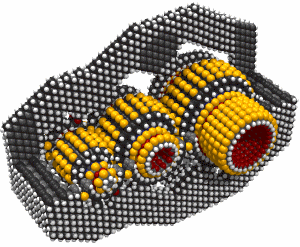The definition of Nanotechnology, found on Wikipedia, includes the following: “Generally, nanotechnology deals with developing materials, devices, or other structures with at least one dimension sized from 1 to 100 nanometers“.

This image, found in a Google search of nanotech images, is what we most often think of, when we think of nanotechnology. Small machines, made out of atoms that mimic what we see in macro machines.
Carbon nano-tubes and Bucky Balls, is the most interesting of what we have produced so far. (Leaving out graphene, which might also be considered nano) Many images, can be found by a Google search for “nanotechnology images”. The other currently available nanotechnology is probably much less exciting to look at than these images.
Over the past year or so, I have been seeing more and more reports of nanotechnology being used to make everything from non-stick coatings to solar hydrogen from waste water. I decided that I needed to look more deeply into these “breakthroughs”. This article is based on my research.
Let’s start with something that looks fairly straight forward. 10 nanometer spheres of Silicon have been used by University of Buffalo researchers to produce Hydrogen when mixed with water.
Now we must first understand that this is a chemical reaction. The Silicon reacts with the water, producing Silicic Acid and Hydrogen. Getting the Silicic Acid “waste product” back to Silicon will require replacing the energy that left the system in the form of the Hydrogen (and most likely more energy because of inefficiencies in the various reactions necessary to accomplish this task.) On the other hand, even though this is not an energy source, it could be a great delivery system!
Another important factor to consider is something called the “cube – square law”. This is a simple mathematical principle the stems from the fact that not all characteristics of a sphere change in the same way when the “size” (diameter) changes. If you reduce the size of the sphere by half, you reduce its surface area by one quarter, but you reduce its volume (and thus its mass) by one eighth. Thus, if you take the material from a one meter sphere and use it to make spheres that are half a meter in diameter, you will end up with eight spheres that have twice the combined surface area of the original one meter sphere. However, in the article, the researchers indicated a 150 times increase in production rates, but a reduction from 100 nanometers to 10 nanometers only produces an increase in surface area of a factor of 10. Obviously there is more going on here than the cube-square law! This looks like it involves more than simple chemistry.
Other sorts of nano particles are being use to produce hydrogen. Aside from hydrogen production nano particles are being used to create self cleaning paint, solar steam, and other materials. Global Spec also has a great tutorial on nano materials.
These are all very interesting, but the real multi-tool seems to be the carbon nanotube. They can be used to improve the charging characteristics of batteries. All by themselves they can be used to make solar cells, and several kinds of thermal energy harvester. The new uses for this material are being announced on a regular basis. If you search YouTube you will find several videos about how to produce your own carbon nanotubes. There are still things to say about carbon nanotubes, and we haven’t even touched on graphene
It is beginning to look like there might be another article here. What do you think?